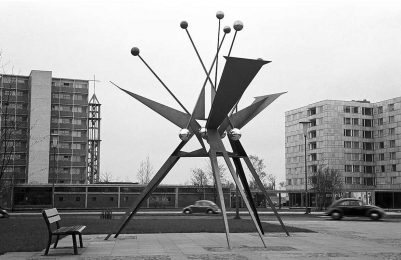Artwork in the Hansaviertel – a wide range of artistic approaches
Many prominent national and international artists made an important contribution to the Hansaviertel with artworks arranged in the wide, open spaces between the buildings, and in the inner courtyards and entrance areas to the buildings. From technically oriented to abstractly biomorphic, from figuratively aesthetic to figuratively abstract, they embraced the artistic traditions of modernism and spoke of the new direction that art should take in post-war Germany. This is demonstrated most excellently in the works of Hans Uhlmann, Fritz Winter, Bernhard Heiliger, Alfredo Ceschiatti and Henry Moore.
Reaching out into the surrounding space in the center of Hansaplatz, the abstract metal sculpture by Hans Uhlmann provides an understated artistic center to the vast square largely undefined by architecture. The untitled metal sculpture, partly polished, partly chrome-plated, is reminiscent of atoms and alludes to a topical socio-political theme at that time. In its permeability and openness, the sculpture also reflects characteristics of the new Hansaviertel. Uhlmann was commissioned following an international sculpture competition that was announced in spring 1957 and judged in September of the same year (1), while another international competition for Interbau decided upon Fritz Winter from Diessen am Ammersee. (2) His glass mosaic on the connecting wall between Hansaplatz subway station and the Hansa Library depicts non-figural patches of color and linear configurations evocative of a landscape, thereby fitting in with the open architecture of the library by Werner Düttmann and its park-like surroundings. In this artwork, Winter’s apprenticeship at the Bauhaus in Dessau is apparent, as is the influence of his teachers Paul Klee, Wassily Kandinsky and Oskar Schlemmer. In the inner courtyard of the library, Bernhard Heiliger’s ‘Vegetative 1’, with its biomorphic shapes, mediates between the right-angular architecture of Werner Düttmann and the abundant floral shapes of the garden design.
Alongside these abstract works, major figurative sculptures also appear in the Hansaviertel. In front of the slab high-rise by the Brazilian architect Oskar Niemeyer sits the bronze ‘Reclining Figure’ (1958) by fellow Brazilian Alfredo Ceschiatti, a sculptor who worked in close cooperation with Niemeyer. With this work, Ceschiatti incorporated classical compositions: the female figure lying on her side, supported by her lower arm and covered only by a cloth over her lower legs, rests contemplatively on a concrete base and turns towards the Niemeyer-Haus. Another ‘Reclining Figure’ (1956) was placed in the entrance area of the Academie der Künste. In this bronze by the British artist Henry Moore, a woman is lying on her side supported by her lower arm, just like the previous sculpture, but her body is much more abstract than Ceschiatti’s design. The artist worked with deformations and openings, which essentially continue the shape and give the female figure a certain vulnerability.
The choice of artists and artworks for the Hansaviertel reflects the wide range of styles of western modernism in the 1950s. Abstract artworks like those by Uhlmann, Winter and Heiliger stand alongside the more figurative depictions by Moore and Ceschiatti. They also reflect a contemporaneous debate, in which the expressiveness of modern art was called into question, above all by Hans Sedlmayr, who worried that modern art wasn’t capable of depicting, or didn’t even want to depict, “an undeformed human image”. (3) As a counterbalance and in defence of non-representational art, several groups of artists were formed, one such being ZEN 49. Initially called the Group of the Non-Objectivists and founded in 1949–50 by Fritz Winter and six other artists, the group promoted their art in several exhibitions. The wide range of artists represented in the Hansaviertel can also be understood as a reaction to the state decreed “socialist realism” of the GDR, which called for a strict verisimilitude, mostly in celebration of workers and peasants, and which excluded abstract and purely aesthetic art.
Dr. Sandra Wagner-Conzelmann
The works of art in the Hansaviertel
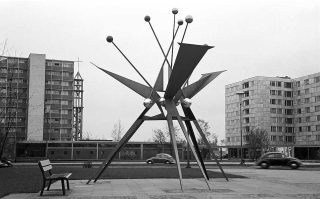
01 / Untitled sculpture, 1958, chrome/nickel/steel, approx. 5.0 x 6.0 m, Hans Uhlmann
Altonaer Straße/Bartningallee
The profiles, rods and spheres of this non-representational sculpture are bundled together on the one hand, but on the other hand radiate upwards. The harmonious Balance of the work corresponded entirely to the basic idea of the new Hansaviertel and was the hallmark of Interbau 1957. Uhlmann received first prize in the lnterbau sculpture competition.
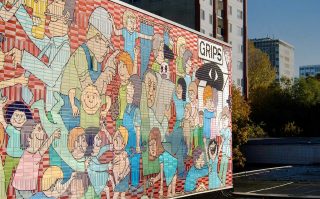
02 / GRIPS wall picture, 1975, tiles, cold painting, 145 qm, Rainer Hachfeld
GRIPS-Theater am Hansaplatz
The mural symbolizes the work of the theatre for young people. It was sponsored by the former Federal President, Gustav Heinemann, up to the stage worker in a solidarity fundraising campaign. Everyone could purchase at least one square metre. The restoration in 1996 was also made possible in the same way.

03 / Twelve reliefs on three doors, 1957, each 1.6 x 2.3 m, Ludwig Gabriel Schrieber
Catholic Church of St. Ansgar, Altonaer Straße
The copper reliefs show individual scenes from the life of St. Ansgar.
Works inside the church: Crucifixion, floor lamp, baptismal font, Ludwig Gabriel Schrieber; Way of the Cross, Tabernacle, Ludwig Peter Kowalski; Madonna, Wood, Johannes Dumanski; St. Anthony, Wood, Paul Baumgarten; St. Ansgar, Bronze, Simon Schrieber
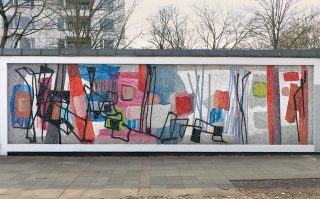
04 / Mural (untitled), 1958, mostly glass mosaic, 9.8 x 2.6 m, Fritz Winter
Outer wall of the U-Bahn station Hansaplatz, southern exit
Fritz Winter, one of the most prominent artists of the post-war period, designed the mural in its original size on cardboard. The execution was done by August Wagner of the Vereinigte Werkstätten, Berlin-Neukölln. The abstract mosaic with its strong colour areas and contrasting black lines signals the spirit of optimism of the time. In 1958 Fritz Winter was awarded the Berlin Art Prize.
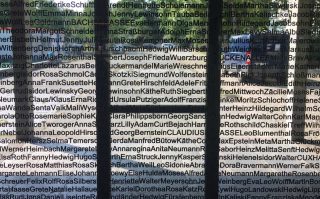
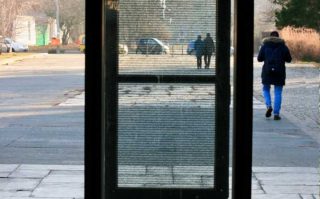
05 / Window of remembrance, 2014, glass pane inscribed, 2.0 x 0.86 m
Katja van Dyck-Taras (Research of the names Tatjana Ruge)
U-Bahn station Hansaplatz, southern exit door
The window of remembrance lists 1030 names of Jews who were once fellow citizens of the old Hansaviertel and who were expelled, deported and murdered between 1942 and 1944. The names are written in upper and lower case without spaces to symbolize the unworthy de-individualization of the Jewish population by the henchmen of the National Socialists. They are deliberately located on a glass pane in the door area of the exit, which has become functionless and which many people pass by every day and become aware of. A piece of memory culture without a raised index finger.
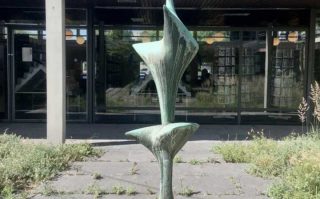
06 / Vegetative, 1957, bronze, 2,5 x 1,5 m, Bernhard Heiliger
Hansabücherei, courtyard, Altonaer Straße 15
The forms of the sculpture swinging towards the light respond to the neighboring plants and at the same time emphasize the meditative character of the atrium of the library, which invites one to linger.

07 / Morning twilight No. 1, 1957, lacquered steel, 3,8 m, Berto Lardera
Platz der Morgenröte (Square of the dawn), in front of the Schwedenhaus
The sheet steel sculpture appears light due to its low material thickness. The brown and black painted forms, some with cut-outs, are inserted into each other and shifted against each other. They offer an attractive view of the surrounding nature and architecture from all sides. Berto Lardera was one of Europe’s most important artists at the time.
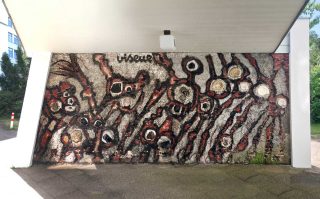

08 / Two murals, in relief, 1957 (?); mixed media, 2,7 x 4,0 m and 2,8 x 6,0 m, artist unknown
Klopstockstraße 14–18, in the area of the entrances
The two dynamic murals stand in a dialogical contrast with Pierre Vago’s clear, light architecture. One, slightly smaller, mural shows an aspiring sculpture in front of a vibrant colour surface. The slightly larger one on the other side of the building is abstract with surreal echoes, integrating snail and stone elements.
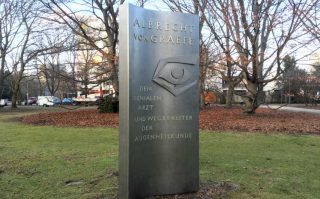
09 / Graefe monument, 1970, stainless steel, 3 m, Edzard Hobbing
Händelallee, southern green area
The monument to the founder of modern ophthalmology, Albrecht von Graefe (1828–1870), stands approximately on the site of his former summer house. The slightly curved cuboid with the relief of an eye was donated and erected on the 100th anniversary of the death of Albrecht von Graefe by the association “Deutsche Augenärzte” (German Ophthalmologists).
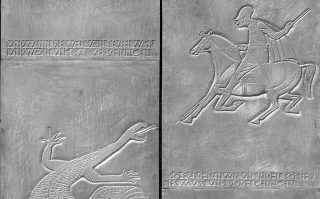
10 / Relief on the middle door, 1957, 1,5 x 2,1 m, Gerhard Marcks
Kaiser-Friedrich Memorial Church, Händelallee
The aluminium relief shows St. Georg fighting with the dragon.
Works inside the church: Window, Georg Meistermann; altar wall mosaics, Ludwig Lemmer and Hans Wagner; pulpit back wall, Hans Stocker; side wall and gallery, Charles Crodel; baptismal font, Walter Rösler; apse window, Heinz Trökes; three round windows, Ludwig Peter Kowalski; crucifixion group in the adjoining room, Willy Fries.
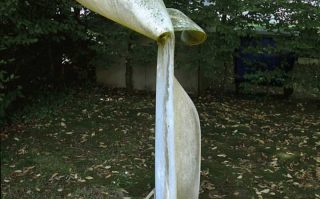
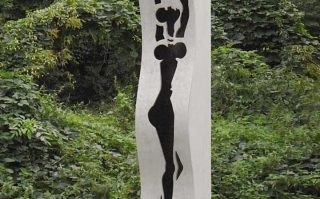
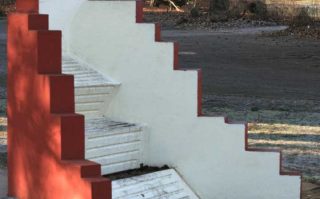
11 / Three sculptures, eternit, Eternit house
Altonaer Straße 1
“Plastic”, 1978, 0.5 x 2.4 m, Kurt lngendahl
Park side of the Eternit-Haus
“Water staircase”, 1.4 x 1.6 m, Holger Uhrig
on the left in front of the house;
“Violet”, 1957, 0.9 x 1.7 m, Fritz Reuter
to the right of the house
The three works are made of the then new building material “Eternit”. They show the three artists’ joy in experimenting with the material, which was still untested at the time, but which has not proven itself in the long run.
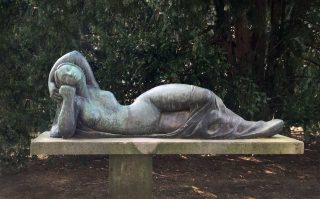
12 / Reclining figure, 1958, bronze on a concrete pedestal, 0,5 x 1,4 x 0,4 m, Alfredo Ceschiatti
Altonaer Straße 4–14
Female nude on a pedestal that reproduces a bed of rest. The sculpture and its vegetable environment refer to the close connection between the built and the grown of the Hansaviertel.
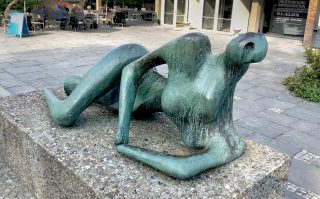
13 / Reclining figure, 1956, bronze, 1,0 x 2,2 x 0,9 m, Henry Moore
Hanseatenweg 10, in front of the Academy of the Arts
The figure of a lying woman made of polished bronze on a concrete pebble pedestal like the academy facade is fitted into the staircase. It is formally related to the elongated entrance area of the building. Henry Moore was one of the great European sculptors of his time. In the garden and courtyard of the academy there are further sculptures by Bernhard Heiliger, Erich Hauser and Fritz König.
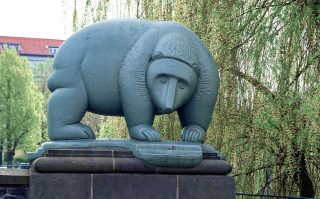
14 / Four bears, 1981, cast iron, ca. 2 x 2 m, Günter Anlauf
Moabiter Brücke, between Bartningallee and Kirchstraße
A stylized bear, partly in mirror image on the four corner pillars of the bridge, replaces the four bears that were created around 1894 by the artists Begas, Boese, Götz and Piper, who were well-known at the time, but melted down in the Second World War.
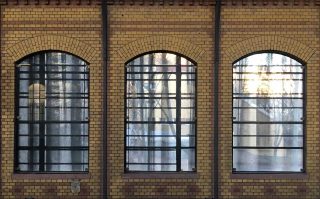
15 / Belle Vue, 1997, silkscreen on glass, size of the station windows, Veronika Kellndorfer
Platform S-Bahn station Bellevue
Seven window openings of the S-Bahn station are filled with several printed glass panels. They show photos of a curtain in the house of the “Deutscher Metallarbeiter Verband”, erected in 1929/30 by Erich Mendelsohn. The view through these windows is also intended to recall the important architectural monument in Kreuzberg.
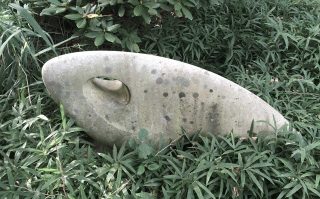
16 / Silverfish, 1960, marble, 1.3 m long, Alfred Trenkel
Kleiner See (Englischer Garten), shore
The stylized fish in its simple, appealing form rests directly on the shore of the “Kleiner See” (small lake) in the English Garden. In summer it is partly covered by vegetation.
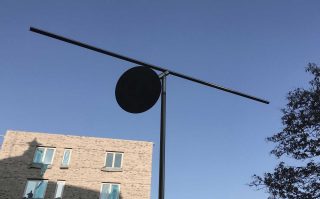
17 / Rod + washer 2, 1989, 10 m high, stainless steel, Ralf Lieberknecht
Cuxhavener Straße 14
The elegant, kinetic sculpture changes its shape and view even with a slight movement of the air. It makes it clear that nothing in the world is static.
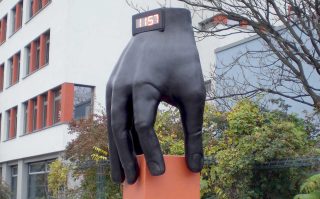
18 / Hand with clock, 1975, nickel silver, height 5,50 m, Joachim Schmettau
Altonaer Straße 26, in front of the Gymnasium Tiergarten
A monumental hand with a modern, digital wristwatch comprises a cube in slight rotation on an offset pedestal. This visually translates the word “comprehend”. In the second half of the last century, Joachim Schmettau created several major works in the city, including the fountain in front of the Europacenter.
The Hand was the “backdrop” in a 1983 music video by the group Depeche Mode (Minute 3.15)
Watch video on Youtube
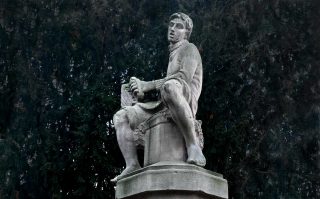
19 / Boatman fountain (Schifferbrunnen), 1914, sandstone, 2,5 x 1,5 m, Hermann Hosaeus
Promenade, east of the Hansabrücke bridge
The former fountain is reminiscent of the shipping trade on the Spree. A singing skipper with accordion sits on a high pedestal with four frogs that seem to give an ironic commentary on the boy’s singing skills. They used to irrigate the fountain.

20 / Athletes, 1982, plastic plate figures, painted, life-size, Ulrike Hogrebe
Altonaer Straße 26, Grammar School Tiergarten
On the four outer walls of the school gym, athletes can be seen in action like a group of runners, a long jumper, a javelin thrower and a high jumper.

21 / The first flight, 1957, glazed clinker clay, 1.8 x 3.1 m, Otto Douglas Hill
On the banks of the Spree, entrance of the Hansa primary school
The sculpture made of multicoloured glazed clinker material represents the flight attempt of a young sea eagle. It symbolizes the children’s first steps into the public space of the school.
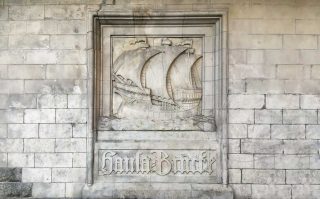
22 / Hansekogge (Hanse cog), ca. 1910, stone relief, 3,5 x 2,5 m, Waller Schmarje
Pillar of Hansabrücke, shore of the Bundesratufer
The relief of the Hansekogge is a relic of the old Hanseatic quarter and was originally located at the bridge house at the eastern bridge entrance, the office and apartment of the bridge keeper, which was destroyed in the Second World War.
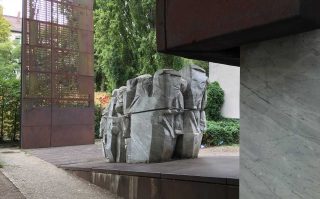
23 / Memorial, 1988, corten steel, marble, multi-part, Jürgen Wenzel, Theseus Bappert; Commemorative Plaque 1960, corten steel, Peter Herbich
Levetzow Straße 7–8
The Huge Memorial, a stylized freight wagon in original size, loaded with marble blocks indicating “human freight”, and an oversized plaque with data recalls the deportations of Berlin Jews. This was once one of Berlin’s largest synagogues with 2000 seats. From 1941 onwards, the National Socialists used the synagogue building as a collection point for the transport of Jews.
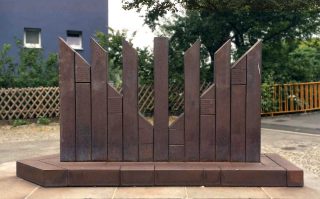
24 / Memory, 1986, corten steel, approx. 2.6 x 1.8 m, Georg Seibert
Siegmunds Hof, Wullenwebersteg
A memorial in memory of the synagogue community “Adass Yisroel”. Steel elements in a row with recesses reminiscent of a Hanukkah chandelier. Inscriptions in Hebrew, German and English on the associated inscription plate, also made of steel, approx. 2.2 x 1.6 m. The artist deliberately chose the heavy, durable material to show that Judaism has not been forgotten and lives in defiance of all persecutions.
